
Norway is a country located in Northern Europe in the northern and western parts of the Scandinavian Peninsula. The majority of the country borders water, including the Skagerrak inlet to the south, the North Sea to the southwest, the North Atlantic Ocean to the west, and the Barents Sea to the north. It has a land border with Sweden to the east; to the northeast it has a shorter border with Finland and an even shorter border with Russia.

Groundcover or ground cover is any plant that grows over an area of ground. Groundcover provides protection of the topsoil from erosion and drought.
An elder is someone with a degree of seniority or authority.

The tree line is the edge of a habitat at which trees are capable of growing and beyond which they are not. It is found at high elevations and high latitudes. Beyond the tree line, trees cannot tolerate the environmental conditions. The tree line is sometimes distinguished from a lower timberline, which is the line below which trees form a forest with a closed canopy.

Cassia is a genus of flowering plants in the legume family, Fabaceae, and the subfamily Caesalpinioideae. Species are known commonly as cassias. The genus includes 37 species and has a pantropical distribution. Species of the genera Senna and Chamaecrista were previously included in Cassia. Cassia now generally includes the largest species of the legume subtribe Cassiinae, usually mid-sized to tall trees.
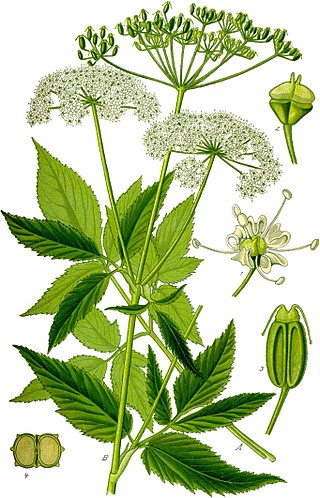
Aegopodium podagraria, commonly called ground elder, is a species of flowering plant in the carrot family Apiaceae that grows in shady places. The name "ground elder" comes from the superficial similarity of its leaves and flowers to those of elder (Sambucus), which is not closely related. Other common names include herb gerard, bishop's weed, goutweed, gout wort, snow-in-the-mountain, English masterwort and wild masterwort. It is the type species of the genus Aegopodium. It is native to Europe and Asia, but has been introduced around the world as an ornamental plant, where it occasionally poses an ecological threat as an invasive exotic plant.

Aegopodium is a plant genus of the family Apiaceae native to Europe and western Asia. It is represented by about twelve species, all are herbs. Flowers are compounded, umbels appearing in spring-summer and are visited by many types of insect pollinators. Fruit consists of two-winged or ribbed nuts that separate on ripening.

The Levant sparrowhawk is a small bird of prey. It measures 32–38 cm (13–15 in) in length with a wingspan of 65–75 cm (26–30 in). The female is larger than the male, but the difference is not as marked as with Eurasian sparrowhawk. The adult male is blue-grey above, with dark wingtips, and barred reddish below.

The dot moth is a moth of the family Noctuidae. The species was first described by Carl Linnaeus in 1761. It is a very distinctive species with very dark brown, almost black, forewings marked with a large white stigma from which the species gets its common name. The hindwings are grey with a dark band at the termen. The wingspan is 38–50 mm. It flies at night in July and August and is attracted to light, sugar and flowers.

The grey dagger is a moth of the family Noctuidae.
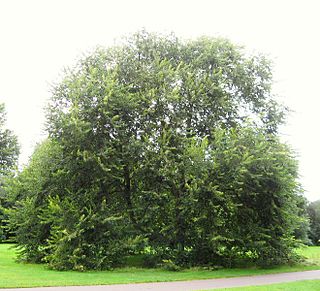
Ulmus villosa, the cherry-bark elm or Marn elm, is one of the more distinctive Asiatic elms, and a species capable of remarkable longevity. It is endemic to the valleys of the Kashmir at altitudes of 1,200–2,500 metres but has become increasingly rare owing to its popularity as cattle fodder. Mature trees are now largely restricted to temples and shrines where they are treated as sacred. Some of these trees are believed to be over 800 years old.
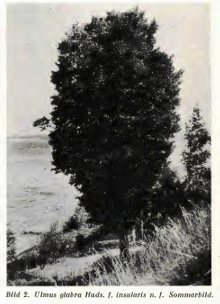
The cultivar Ulmus glabra 'Insularis' [:'island'], the Ven island elm, a fastigiate form of Wych Elm from Sweden, was identified and described by Nilsson in Lustgården 30: 127. 1949, as U. glabraHuds. f. insularis. Nilsson considered it "closely related to subspecies montana(Stokes) Lindqvist". The cultivar arose from a tree on Ven island in Öresund sound, planted c.1900 between Haken and Husvik, possibly from self-sown local seedlings, and approaching 2 m in girth by the late 1940s.

Hypena proboscidalis, the snout, is a moth of the family Erebidae. The species was first described by Carl Linnaeus in his 1758 10th edition of Systema Naturae.

Brian Laurence "Bill" Burtt FRSE FLS, was an English botanist and taxonomist who is noted for his contributions to the family Gesneriaceae. In a career that spanned 74 years, he worked first at the Royal Botanic Gardens, Kew, and then at the Royal Botanic Garden Edinburgh (RBGE). He made numerous field trips to South Africa and Sarawak and described a total of 637 new plant species. Burtt is denoted by the author abbreviation B.L.Burtt when citing a botanical name.

Agonopterix angelicella is a moth of the family Depressariidae. It is found in most of Europe, except the Iberian Peninsula and south-eastern Europe. It is also found on the Russian plain and Siberia and in Japan.

Agonopterix ciliella is a moth of the family Depressariidae. It is found in most of Europe, except the Iberian Peninsula, most of the Balkan Peninsula and the Benelux. It is also found in North America.
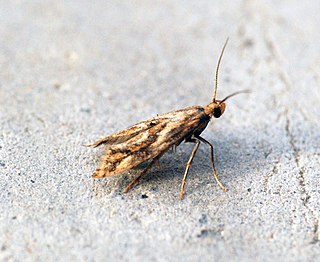
Epermenia falciformis, also known as the large lance-wing, is a moth of the family Epermeniidae found in Europe. It was first described by Adrian Hardy Haworth in 1828.

Montane ecosystems are found on the slopes of mountains. The alpine climate in these regions strongly affects the ecosystem because temperatures fall as elevation increases, causing the ecosystem to stratify. This stratification is a crucial factor in shaping plant community, biodiversity, metabolic processes and ecosystem dynamics for montane ecosystems. Dense montane forests are common at moderate elevations, due to moderate temperatures and high rainfall. At higher elevations, the climate is harsher, with lower temperatures and higher winds, preventing the growth of trees and causing the plant community to transition to montane grasslands and shrublands or alpine tundra. Due to the unique climate conditions of montane ecosystems, they contain increased numbers of endemic species. Montane ecosystems also exhibit variation in ecosystem services, which include carbon storage and water supply.
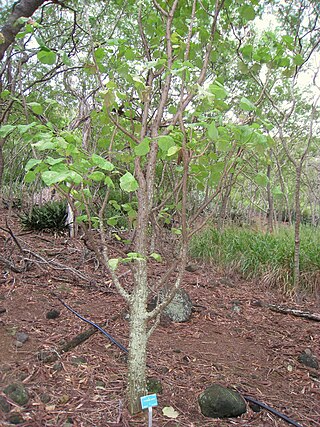
Erythrina burttii is a flowering plant species in the genus of Erythrina found in Kenya and Ethiopia.

Etlingera burttii is a monocotyledonous plant species described by Axel Dalberg Poulsen. Etlingera burttii is part of the genus Etlingera and the family Zingiberaceae. No subspecies are listed in the Catalog of Life.


















